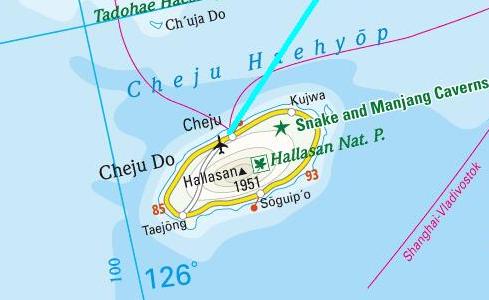-- FromBusan to Jeju Island, back to Busan

The road tracklog
from Busan to Busan
from 2010/12/18 to 2010/12/21
On Saturdays December 18 after a 50-minute flight and a transfer by 20-minute bus according to my usual rhythm I deposited my luggage at the hotel, I stopped at the Tourist Office then I undertook to visit three sights in Jeju-si, the administrative capital of the island. But before I sacrificed to the pilgrimage at Yongduam Rock which has interest only for Korean, it is a piece of lava in the sea like a head of dragon, with much of imagination. But on the way a pretty pavilion, Yeongyeon, overhang a idyllic cliff, one says that civil servants of the local government during the Kingdom of Joseon came banqueter by reciting poems.
Yongyeon
Jeju-si
18/12/2010
Indeed the administrative centre of the Kingdom of Joseon, Jeju-Mok Gwana, is a whole of austere buildings favourable to develop the virtue. Mannequins in costume of the era show the civil and military activity of this time.
Jeju-Mok
Jeju-si
18/12/2010
Jeju-Mok
Jeju-si
18/12/2010
Jeju-Mok
Jeju-si
18/12/2010
Jeju-Mok
Jeju-si
18/12/2010
A little further away Samsunghyeol is the place where the three demi-gods at the origin of the Kingdom of Tamna emerged. The site is a broad raised park where buildings hide under foliages. Alas the track which skirts the site of the three holes from which came up the three deities does not make it possible to see them! (see the Gallery)
Samseonghyeol
Jeju-si
18/12/2010
Samseonghyeol
Jeju-si
18/12/2010
Samseonghyeol
Jeju-si
18/12/2010
I finished this cultural trip, without monastery, by the Folklore & Natural History Museum which exhibits in particular the volcanic activity on the island and the Lava Tubes which were listed in the World Heritage. In front of the building some statues of Dolhareubang stand up stately.
Dolharreubang
Jeju-si
18/12/2010
Dolhareubang
Jeju-si
18/12/2010
For a backpacker the access to Mangjanggul Lava Tube was a true expedition. Left from the hotel at 8 am for a short walk up to a Bus 100 stop to the Local Bus Terminal, then the bus 1132 up to the stop at the junction of the road for the site and finally a walk of 25 minutes to the entry of the site. I arrived at 9:45. The outward journey and return with the latencies of buses lasted a little more than four hours for one hour thirty of visit. According to the Lp it is more efficient to have "His own wheels" But the site is worth it well. Any well considered it is not a dug tunnel, but a tube produced by the solidification of the lava on the surface and the flow of the molten lava inside leaving some layouts as well as on vault as on walls and on ground. The tube is not rectilinear, it meanders like a river. The trip is peppered with informational panels I give the most significant examples. The site is listed in the World Heritage.
Manjanggul Lava Tube
Jeju-do
19/12/2010
Manjanggul Lava Tube
Jeju-do
19/12/2010
Manjanggul Lava Tube
Jeju-do
19/12/2010
Manjanggul Lava Tube
Jeju-do
19/12/2010
Manjanggul Lava Tube
Jeju-do
19/12/2010
Manjanggul Lava Tube
Jeju-do
19/12/2010
Manjanggul Lava Tube
Jeju-do
19/12/2010
Manjanggul Lava Tube
Jeju-do
19/12/2010
Manjanggul Lava Tube
Jeju-do
19/12/2010
Manjanggul Lava Tube
Jeju-do
19/12/2010
I had two purposes by coming to Jeju-do, the first to see a Lava Tube and the second to climb the Mt Hallasan. On Monday 20 December I took a bus to go to Seongpanak starting point of the one of the three tracks for the summit -Baeknokdam- (White deer pond) at 1950 meters of altitude. By arriving I noted that the track was icy by the freezing during the night and thus impracticable without equipment. I warned a graver on the carpark and by entering I have the pleasant surprise to see a counter with cramps sold at the exorbitant price of 32.000 KRW (approximately 22€). I did not hesitate. I undertook the climb around 8:30 and approximately three hours later I was at the top of the track in front of the caldera at 1927 meters GPS by trekking 9,6 km. A legend tells that spiritual-immortals -Shinseong- on white deer ridded around the lake. Great moment of plenitude after the effort and of gratification in front of a dramatic landscape. After a lunch pause I returned back by the same way.. A descent is increasingly more difficult than the rise and moreover tiredness makes it more painful.
Le chemin d'Hallasan
Jeju-do
20/12/2010
Mt Hallasan
Jeju-do
20/12/2010
Mt Hallasan
Jeju-do
20/12/2010
The Caldera
Jeju-do
20/12/2010
Guy, at the summit
Jeju-do
20/12/2010
The next day was a transition day to return by plane to Busan and on Wednesday December 22 I travelled by another plane to Fukuoka, Japan. The journey in Korea had finished in apotheosis at the Mt Hallasan.